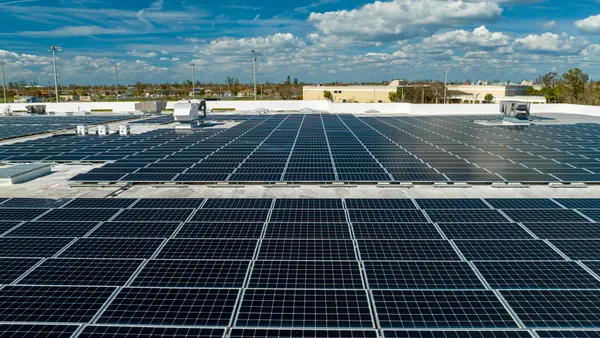Dive Brief:
- The California Public Utilities Commission is proposing to dismiss an application from Sunnova Community Microgrids California to own and operate microgrids that would be constructed as part of new, residential communities that will include up to 2,000 homes and a few non-residential facilities.
- In an application filed with the agency last September, Sunnova proposed to operate as a “microutility” for each of these master-planned communities, essentially serving as an electrical corporation that serves fewer than 2,000 customers.
- However, a proposed decision issued by a CPUC administrative law judge, or ALJ, Feb. 14 would dismiss this application, in part because it says the company is seeking unauthorized exemptions and has not provided regulators with adequate information.
Dive Insight:
Sunnova’s application comes against the backdrop of California’s broader push to bring online more clean energy resources and ensure the reliability of its electric grid.
In its proposal, the company described a series of new, master-planned residential communities — each including between 500 and 2,000 homes and some commercial facilities, like electric vehicle charging stations and schools — and asked for approval to own and operate microgrids that would be constructed as part of these communities. Each home would be fitted with solar generation and battery storage, the company said, and connect to a microgrid that would comprise a community-scale solar system, battery storage system and an on-site emergency generator.
California regulations define an electric microutility as an electrical corporation, regulated by the CPUC and “organized for the purpose of providing sole-source generation, distribution, and sale of electricity exclusively to a customer base of fewer than 2,000 customers.”
However, the CPUC’s Public Advocates Office filed a motion to dismiss Sunnova’s application last October, contending it would allow the company to operate under “drastically limited regulations and waived rules, including those pertaining to important consumer and ratepayer protections.”
The office also argued that the company’s requests are based on “unsubstantiated claims” and do not include basic information required for a certificate of public convenience and necessity.
The proposed decision — which the CPUC can vote on at the earliest April 6 — concluded that the exemptions that Sunnova is seeking are unauthorized. In particular, the proposed decision points to the agency’s statutorily required responsibility of overseeing electricity rates in the state.
In its application, Sunnova proposed entering into agreements for market-based, negotiated electric supply and microgrid service rates with customers. It stated that the commission would still retain oversight of its rates, and the terms and conditions of its service.
However, the proposed decision states that some of the authorities that Sunnova is seeking — including a waiver of certain affiliate transaction rules — would mean the CPUC abdicating its responsibility of ensuring just and reasonable rates.
The agency also raised concerns that Sunnova’s application did not include enough information needed to evaluate a certificate of public convenience and necessity, that would authorize the construction and operation of the microgrids, like preliminary engineering and design information, and estimated costs of financing and construction.
While some of the feedback that Sunnova’s application received is constructive, some of the questions posed by the Public Advocates Office are more suited for projects that are tied to a very specific geography, according to Adam Miller, vice president of microgrids at the company.
In the case of this application, “the construct really needs to be solidified — and that’s why we filed the application to become a company that can bring a pipeline of projects like this to California, and hopefully inspire others to do so as well,” he said.
On the issue of providing adequate information for a CPCN, “I think we did provide sufficient technical detail as to what we plan to do,” he said, including the technical design of the equipment, a design for the distribution infrastructure itself, the point of interconnection, as well as the centralized energy resources.
More broadly, Miller said a more appropriate response from regulators would be to acknowledge the depth that the company went into for a simulated project, and that the construct Sunnova is proposing would work, so that businesses and institutions who want to bring forward plans for sustainable communities like these could invest more heavily in them.
“I think the response of just dismissing the application without providing the guidance that this construct is welcome, it discourages community microgrids like this from actually occurring — and I don’t think that’s what anybody wants,” he said.
The CPUC’s Public Advocates Office supports innovation around microgrids, spokesperson Mary Flannelly said in an email.
“However, Sunnova seeks exemptions from key laws and regulations that ensure equitable access to service, that rates are just and reasonable, and that there is continuity of service and safety standards are met,” she said.
The CPUC is currently working on a separate proceeding to commercialize microgrids, which would be a better forum to develop a coordinated, comprehensive approach to microgrid implementation than individual applications, Flannelly added.
More broadly, while the office sees potential for microgrids as one of the solutions that can help California meet its clean energy and reliability goals, “the commercialization of microgrids should be undertaken in a coordinated way that develops a robust approach to protect ratepayers and further the state’s goals,” she said.














